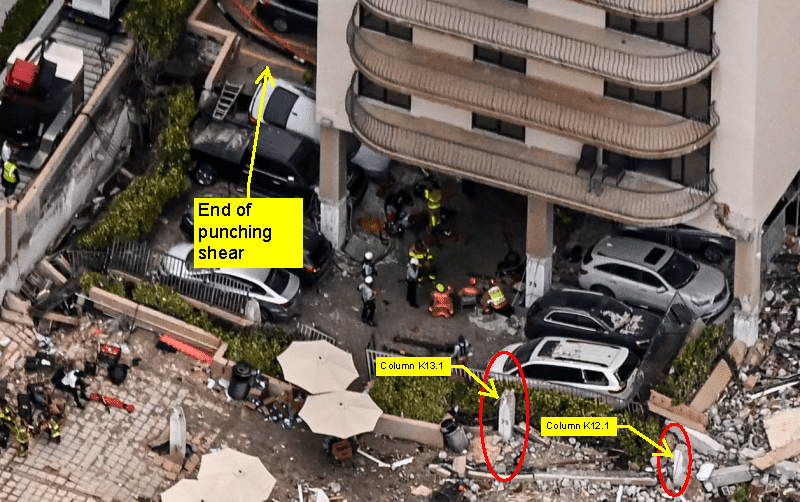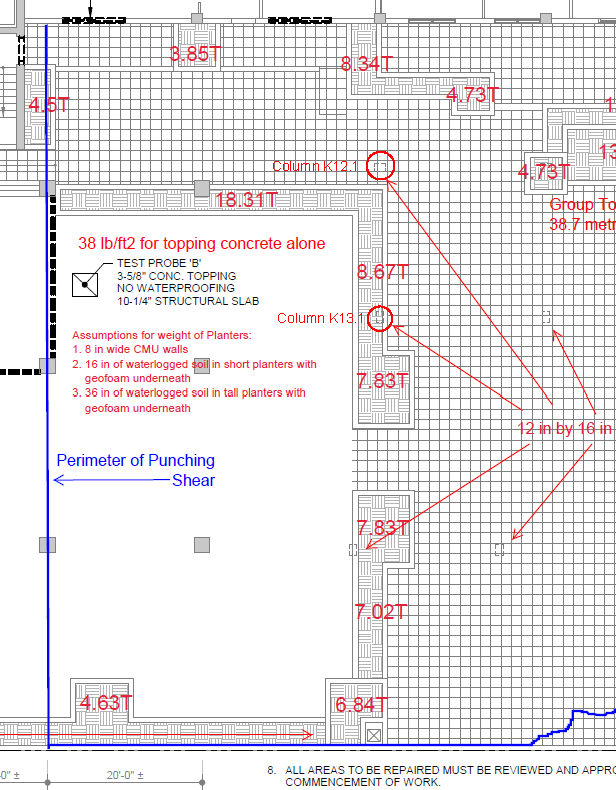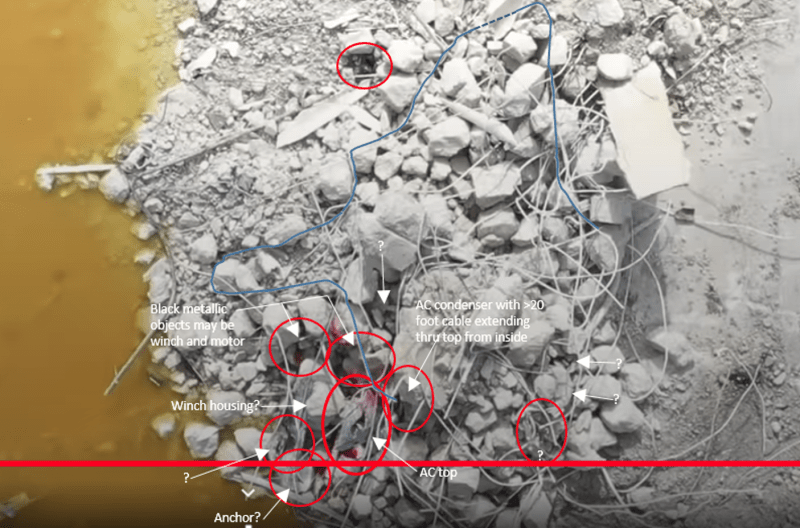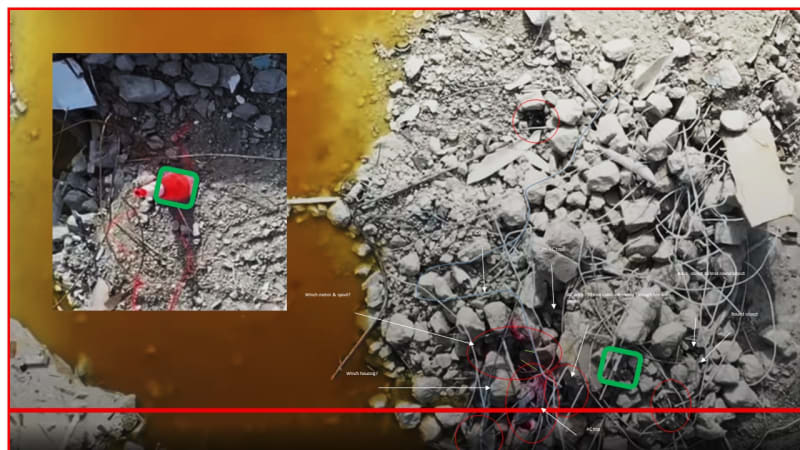It’s me again. But before you begin the ridicule again, please hear me out.
The photo below shows the debris pile that was left at the end of the ramp for two days after everything else was removed. I believe that this was done because the Miami Dade recovery crew believed that the pile contained important evidence about the collapse. The importance of this evidence is clear from their using red paint to identify some of the objects and by their use of red cones connected by red tape on the ramp to keep away curious people who might tamper with the evidence.
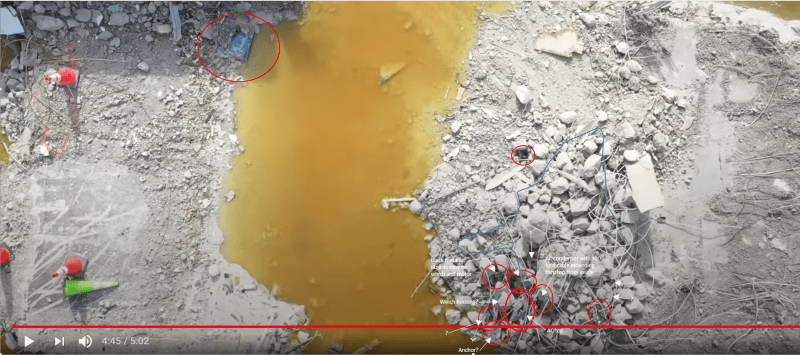
I encourage you to zoom in on the objects marked in the photo to see what they are. To help you to do so, I have enclosed a digital PNG version of the photo that allows zooming in by rotating the mouse wheel forward after opening the document in Windows 10. You can also re-center the objects as you zoom in by clicking on the window and then moving the mouse from side to side or up and down. I have also enclosed in the following post a PowerPoint document containing the same photo that allows one to zoom in by using the slide button in the lower right hand corner. This document also allows one to selectively remove any annotation that obscures an object and to add new annotation as desired by the viewer.
What I found recently by inspecting this photo, and what you can see yourself by zooming in on it, is shown in the following figure.
One sees that there is a large amount of wire cable on the pile that does not seem to be evident in debris photos taken at other locations. I was able to trace at least 20 feet of this cable, although there is much more, perhaps over a hundred feet. Most importantly, I found that one end of it goes into the circular top of an object of interest on the debris pile as shown in the following figure.
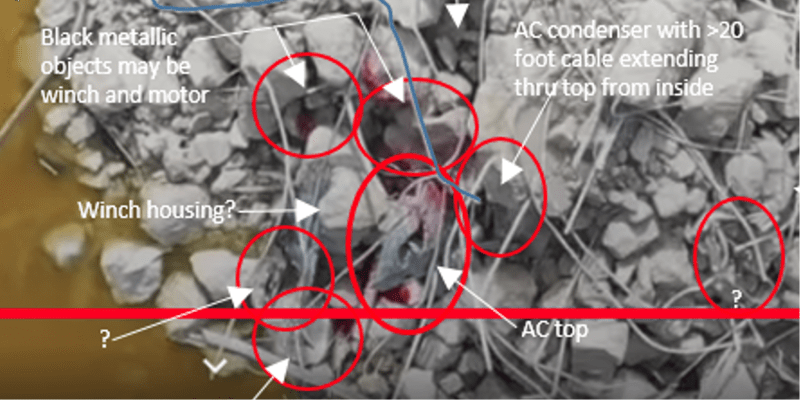
I believe this object is the condenser of an air conditioning unit. Near this object lies a square piece of sheet metal with rounded corners that has a circular hole inside. I believe that this the metal top of the air conditioning unit. One would expect the cable to go through this circular hole as well. But one can see a slot in one side of the top that has allowed the cable and top to be separated. This slot could have been made by the recovery crew to allow easier inspection of the top, or could have been made by pulling on the cable by a power shovel while the top was still covered by the debris pile.
Now, I would wager that it is no accident that this cable extends into the internal condenser part of an air conditioning unit. Normally, the top of an air conditioning unit is covered by a wire grating that would prevent a cable from randomly penetrating inside. However, if one wanted to raise or lower an air conditioning unit with a cable, instead of putting it on a platform or using a lifting sling in some manner, it is easier to just remove the circular grating in the metal top and pass the cable hook through the top opening, then around a compressor support bracket at the bottom of the condenser, and then reattach the hook to the cable again. This alone would indicate that a human being was responsible for attaching the air conditioning unit to the cable.
So, why is the object of interest (whether an AC or some other object) still intact and still attached to the cable after the building has collapsed? Clearly, something went wrong during the raising or lowering of the object that prevented the person involved from detaching the cable. This something that went wrong could not have happened near the top of the building, because then nearly all of the cable would still be in the winch and not strewn all over the debris pile with the object still attached. Therefore, it must have happened near the pool deck. But if the winch malfunctioned in some way to cause the object to fall freely to the pool deck with the cable still attached, then the object likely would have been dented beyond all recognition by the collision with the deck floor. Clearly, the TikTok video shows that this object is still relatively intact. But what if the something that went wrong occurred just a few feet above the pool deck? This could happen if the cable was not long enough. In this case, the users involved might be tempted to gain a few more feet to safely put the object on the deck by tilting the crane at the top a little bit. But when this was done, the change in the crane’s center of gravity could have caused the crane to press against the parapet, causing a moment arm of over 7 feet (4 feet of parapet height plus 3 feet of clearance) with over 300 pounds of force to be applied. This may have caused part of the parapet to give way, sending it crashing down onto the most sensitive part of the building’s structure; namely, the beam between column 27 (column M10) and column M11.1. In this case, the object of interest would fall only the distance of one floor plus a few more feet, which would enable it to stay relatively intact. It would also have resulted in the object of interest falling midway between the hoist counterweights on the debris pile as observed in other photos because the object would have been pulling down on the hoist structure, thereby keeping it centered on the object.
Some further thoughts about this scenario are as follows:
1) It is likely that there was a second person at the bottom of the building as well as one at the top. This is likely because someone is required at the bottom to remove the hoist hook from the object and cart it away, while someone at the top controls the hoist. This second person was likely in cell phone communication with the one at the top. This would have allowed almost silent operation under normal circumstances after 12:00 AM at night. But this second person might have been seen by a surveillance camera having a line of sight over the patio area of the pool deck. This person at the bottom would have been exposed to the falling parapet and may have been injured or even worse. Nothing has been mentioned by the recovery crew about finding a person near the object of interest.
2) The amount of cable required would have been at least 120’ 8” to cover the distance from the penthouse roof floor to the pool deck below. An additional 8 feet or more would have been required to get over the penthouse parapet (4 feet tall), the height of the air conditioner (3 to 4 feet), and either a cable pulley or a winch (1 foot), thus adding an additional 8 to 9 feet. Therefore, the total cable length required would have been 129 to 130 feet. Most commercial winches have only 120 feet of cable, some have 130 feet, but very few have over 130 feet. Therefore, the amount of cable needed was right at the limits of most available winches.
3) With the pulley or winch needing to be 8 to 9 feet above the penthouse floor, the hoist would have been quite tall. Also, it would have needed to extend at least two to three feet over the parapet to clear a 3 foot square object like an air conditioner, so it would have required a counterbalance over 8 feet long with weights greater than 300lb x 3/8 = 100 lbs to stabilize the hoist in two directions. Two hexagonal weights on rods were found on the debris pile that could serve this purpose. Also, this large hoist would likely have been present when the building inspector was on the roof the day before the collapse, so he should be able to give a description of the hoist.
4) A winch would have been attached to the hoist structure. This winch would have fallen to the pool deck below with the hoist structure, probably causing the winch to be seriously damaged. An object was found on the debris pile that appears to be this winch, with the motor and cable spool separated from the housing. However, no other parts of a hoist structure have been observed except for the two counterbalances and possibly a pulley.
5) Operation of a hoist on a roof requires that the hoist have a tie-down cable to a secure building structure to prevent it from falling. There was no such secure building structure on the penthouse roof near the hoist at the time. Therefore, the workers may have used the aluminum framework of the air conditioner mounts as a tie-down structure. Evidence of an aluminum framework with a second air conditioner attached can be found on the debris pile at the end of the ramp.
6) Could the falling of the penthouse parapet wall above and its crashing to the deck correspond to Maud’s first stage of collapse? The second stage of collapse has been identified as being caused by the falling of the pool deck, which might have taken place after a short pause.
7) Could the “knocking sounds” or “hammering on the roof” heard by a tenant and by the night watchman before the collapse have been caused by compressed air guns being used to remove air conditioners from their mounts prior to moving them?
8) Could the weird smells noticed by some tenants have been caused by the refrigerant being released from the air conditioners that had fallen? This refrigerant is a gas that normally has a faint smell like either ether or chloroform that some people might find to cause a disagreeable odor. Each air conditioner has about two to three pounds of this gas inside that takes about a half hour to release completely. With a total of about sixty or more air conditioners on the roof falling at the same time, this would have caused over 150 pounds of this gas to be released all at one time, which would have been noticeable throughout the collapsed building.
9) There may be a witness who can tell us who was on the roof that night. The security desk employee should have seen anyone who entered the elevator after hours while wearing working clothes. And this same security desk employee may also have seen them exit the elevator to leave the building after the pool deck collapsed, which he/she should also have seen by watching one of the security cameras. Has anyone asked the security employee about these topics?
I will leave it to others to explain who may have been on the roof that night to trigger this sad sequence of events because of potential liability concerns. Suffice it to say that the trigger for the collapse was likely an industrial accident created by carelessness and stupidity, and not merely by structural deficiencies as bad as they were to everyone’s agreement, including my own. Without this trigger, no one knows how long the building could have remained standing with all its deficiencies. The case is equivalent to an old and unhealthy person being run over by an automobile driven by a careless driver. No matter how old or how unhealthy the old person is, the cause of death is still an automobile accident caused by a careless driver. One can introduce new health measures to keep an old person functioning longer, but only by stopping careless driving can one prevent automobile accidents that cause the death of older people.
Enclosure 1 (1st post below):
PowerPoint document: Overheads of debris pile at end of ramp (zoom with slide in lower RH
Enclosure 2 (2nd post below):
PNG photo: Overhead of debris pile at end of ramp (zoom with mouse wheel & re-center by moving mouse)


